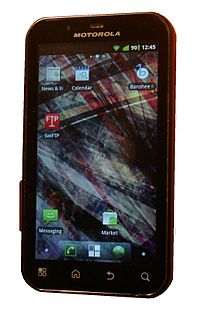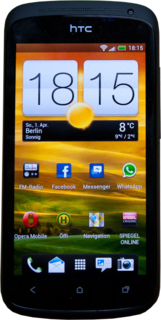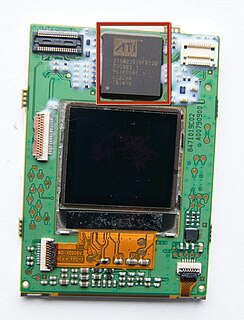Related Research Articles

The OMAP family, developed by Texas Instruments, was a series of image/video processors. They are proprietary system on chips (SoCs) for portable and mobile multimedia applications. OMAP devices generally include a general-purpose ARM architecture processor core plus one or more specialized co-processors. Earlier OMAP variants commonly featured a variant of the Texas Instruments TMS320 series digital signal processor.
Adreno is a series of graphics processing unit (GPU) semiconductor intellectual property cores developed by Qualcomm and used in many of their SoCs.

Snapdragon is a suite of system on a chip (SoC) semiconductor products for mobile devices designed and marketed by Qualcomm Technologies Inc. The Snapdragon's central processing unit (CPU) uses the ARM architecture. A single SoC may include multiple CPU cores, an Adreno graphics processing unit (GPU), a Snapdragon wireless modem, a Hexagon digital signal processor (DSP), a Qualcomm Spectra image signal processor (ISP) and other software and hardware to support a smartphone's global positioning system (GPS), camera, video, audio, gesture recognition and AI acceleration. As such, Qualcomm often refers to the Snapdragon as a "mobile platform". Snapdragon semiconductors are embedded in devices of various systems, including Android, Windows Phone and netbooks. They are also used in cars, wearable devices and other devices. In addition to the processors, the Snapdragon line includes modems, Wi-Fi chips and mobile charging products.
Vivante Corporation is a fabless semiconductor company headquartered in Sunnyvale, California, with an R&D center in Shanghai, China. The company was founded in 2004 as GiQuila and focused on the portable gaming market. The company's first product was a DirectX-compatible graphics processing unit (GPU) capable of playing PC games. In 2007, GiQuila changed its name to Vivante and changed the direction of the company to focus on the design and licensing of embedded graphics processing unit designs. The company is licensing its Mobile Visual Reality to semiconductor solution providers that serve embedded computing markets for mobile gaming, high-definition home entertainment, image processing, and automotive display and entertainment.
Rockchip is a Chinese fabless semiconductor company based in Fuzhou, Fujian province. Rockchip has been providing SoC products for tablets & PCs, streaming media TV boxes, AI audio & vision, IoT hardware since founded in 2001. It has offices in Shanghai, Beijing, Shenzhen, Hangzhou and Hong Kong. It designs system on a chip (SoC) products, using the ARM architecture licensed from ARM Holdings for the majority of its projects.
Google Nexus is a discontinued line of consumer electronic devices that run the Android operating system. Google managed the design, development, marketing, and support of these devices, but some development and all manufacturing were carried out by partnering with original equipment manufacturers (OEMs). The line also included tablets and streaming media players, though neither type of device are currently available. The most recent tablet was the Nexus 9, and the most recent streaming media player the Nexus Player.

The Motorola Defy (A8210/MB525) is an Android-based smartphone from Motorola. It filled a niche market segment, by being one of the few small, IP67 rated smartphones available at the time of its late 2010 release. It is water resistant, dust resistant, and has an impact-resistant screen. The phone was launched unlocked in Germany, France, Italy, Hungary, India, Thailand, Spain, the UK, Turkey, Romania and Greece under various networks and was distributed exclusively by a number of carriers, including T-Mobile in the United States, Telus in Canada, and Telstra and Optus in Australia. An updated version of the original MB525, Defy+ (MB526) is also available.

The Veer is a smartphone announced by HP on February 9, 2011. The device uses HP webOS, is powered by a Qualcomm Snapdragon processor, and has a 2.6-inch screen. The smartphone is notable for its credit card-sized dimensions. The device is seen as the successor in the Palm line-up to the Pixi and earlier Centro models.

The ARM Cortex-A7 MPCore is a 32-bit microprocessor core licensed by ARM Holdings implementing the ARMv7-A architecture announced in 2011.
Hexagon is the brand name for a family of digital signal processor (DSP) products by Qualcomm. Hexagon is also known as QDSP6, standing for “sixth generation digital signal processor.” According to Qualcomm, the Hexagon architecture is designed to deliver performance with low power over a variety of applications.

The HTC One S is a premium smartphone designed and manufactured by HTC as part of the HTC One series which has Beats Audio and runs the Android 4.0 "Ice Cream Sandwich" mobile operating system with HTC Sense. Announced by HTC on 26 February 2012, the HTC One S was scheduled for official release on 2 April 2012. The first phones were sold on March 30. In the United States, the One S is carried by T-Mobile and Solavei.
Scorpion is a central processing unit (CPU) core designed by Qualcomm for use in their Snapdragon mobile systems on chips (SoCs). It was released in 2008. It was designed in-house, but has many architectural similarities with the ARM Cortex-A8 and Cortex-A9 CPU cores.
Qualcomm Krait is an ARM-based central processing unit included in the Snapdragon S4 and earlier models of Snapdragon 400/600/800 series SoCs. It was introduced in 2012 as a successor to the Scorpion CPU and although it has architectural similarities, Krait is not a Cortex-A15 core, but it was designed in-house. In 2015, Krait was superseded by the 64-bit Kryo architecture, first introduced in Snapdragon 820 SoC.
The Droid Maxx is a smartphone developed by Motorola Mobility. It is the first Droid to be a high end smartphone exclusively developed by Motorola for Verizon Wireless. It is part of the Verizon Droid line, and was announced on 23 July 2013 along with the Droid Ultra and Droid Mini at a joint Motorola and Verizon Wireless press conference.

Imageon was a series of media coprocessors and mobile chipsets produced by ATI in the 2000s, providing graphics acceleration and other multimedia features for handheld devices such as mobile phones and Personal Digital Assistants (PDAs). AMD later sold the Imageon mobile handheld graphics division to Qualcomm in 2009, where it was used exclusively inside their Snapdragon SoC processors under the Adreno brand name.
The ARM Cortex-A73 is a microarchitecture implementing the ARMv8-A 64-bit instruction set designed by ARM Holdings' Sophia design centre. The Cortex-A73 is a 2-wide decode out-of-order superscalar pipeline. The Cortex-A73 serves as the successor of the Cortex-A72, designed to offer 30% greater performance or 30% increased power efficiency.
This is a list of devices using Qualcomm Snapdragon chips. Snapdragon is a family of mobile system on a chip (SoC) made by Qualcomm for use in smartphones, tablets, and smartbook devices.
The ARM Cortex-A78 is a microarchitecture implementing the ARMv8.2-A 64-bit instruction set designed by ARM Ltd.'s Austin centre, set to be distributed amongst high-end devices in 2020–2021.
References
- ↑ "Motorola Reveals More Details Of The Mysterious X8 Chip". Androidpolice.com. 2013-07-31. Retrieved 2013-08-05.
- ↑ Also Read (2013-07-25). "A look at Motorola's X8 Mobile Computing System - Mobile Phone | ThinkDigit Features". Thinkdigit.com. Retrieved 2013-08-05.
- ↑ Segan, Sascha (2013-07-31). "Motorola Reveals More X8 Chip Details | News & Opinion". PCMag.com. Retrieved 2013-08-05.
- ↑ Dante D'Orazio (2013-07-23). "Motorola using its own multi-core chip in new Droids (update)". The Verge. Retrieved 2013-08-05.